
AT $47,200 drive-away, the Honda Civic is the catalyst for this comparo. It’s the sole Civic on offer in Australia now that Honda’s local office has (vastly) simplified the line-up by reducing it to a single spec, and the first all-new model to transition to the company’s non-negotiable national drive-away pricing scheme. Think you’ll be able to haggle the dealer down? Forget about it.
That’s a lot of dosh for a small hatchback, even factoring in the inclusion of all on-road costs, so it begs the question: why buy a Civic when there are so many other options at the circa-$50k mark from brands that aren’t averse to negotiation?
Shopping at this price point opens the door to things like powerful midsize sedans and brands with proper premium cachet, not to mention a bevy of hot hatches and ultra-pragmatic mid-size and large SUVs. You can get a base Mazda CX-9 Sport for $46K before on-roads, for crying out loud, so where’s the value in a $47K small hatchback? We’re gonna find out.

We’ve got a small mainstream hatch, an entry-level premium sedan, and a feature-packed mid-size four-door. Only the presence of a turbo four-cylinder mounted east-westwards under their bonnets unifies this bunch, because in most other respects they are very disparate cars pitched at rather different demographics.
Factor in price, however, and they’re surprisingly close bedfellows. Like the Civic, which launched here at the end of last year, the Audi A3 is fresh metal. We’ve pinched the range-opening A3 35 TFSI sedan which, with a $49,400 retail sticker, is within coo-we of the Honda.
Opting for the five-door A3 Sportback bodystyle can trim the pricetag even further to $46,900, making the Audi A3 the most affordable small premium car in the country while still netting the same feature set as the sedan – save for an electrically-opening bootlid.
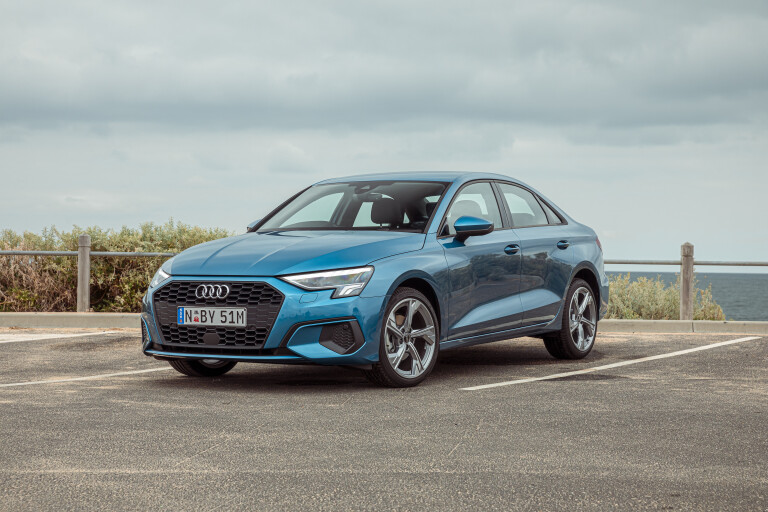
The presence of Hyundai’s Sonata N-Line may seem a little incongruous, because compared to the Civic and A3 it’s something of a whale – or a catfish, if that gaping maw of a front end is to be judged. Hailing from a size class above the other two, the Sonata doesn’t just exude a big-car feel, it flaunts a level of standard equipment that the A3 and Civic simply can’t rival (see breakout).
There’s also the considerable value offered by its turbocharged 2.5-litre engine, which cranks out nearly double the power of the Audi and 82kW more than the Honda. If you measure value in features-per-dollar, dollars-per-kilowatt or square-footage-per-dollar, then the Hyundai has already won this comparo.
The A3, on the other hand, is a bit of a stripper spec. The car you see here has been helped out a bit with some options, however, none which alter the driving experience.

That said, subtracting them would leave you with something very Spartan: the base A3’s faux leather upholstery, flat seats and spongy soft-touch surfaces (particularly those used on the door cards) aren’t aligned with the premium promise of those four rings in the grille, and the 50-shades-of-grey cabin furniture leans heavily on surfaces that don’t age well, like hard scratchy plastics and piano-black trims.
Key touchpoints like the steering wheel and door handles do look and feel upmarket, and the dashboard design is functional and modern, but if you were expecting a high-end aura then A3 35 TFSI may disappoint.
And forgive us for being shallow, but appearances matter. The A3’s sheetmetal has been styled with pronounced quarterpanels, the subtly bulging bodywork around each wheelarch hinting at the brand’s all-wheel drive heritage and performance nous.
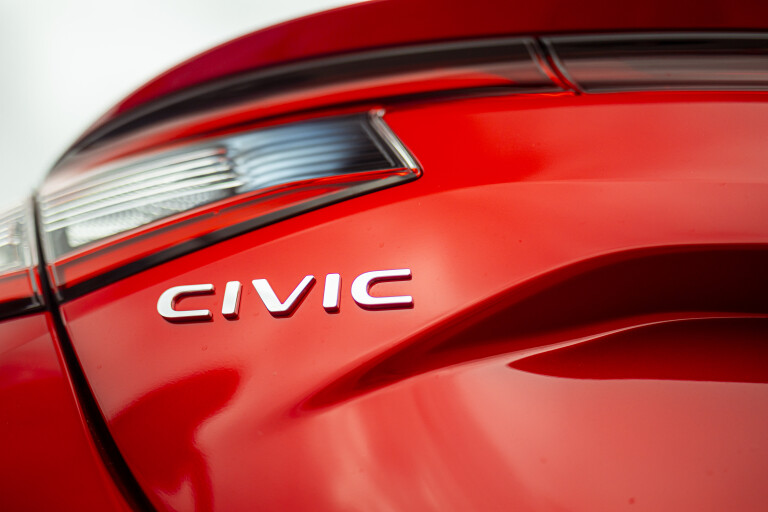
The only problem is, the 35 TFSI is strictly a front-drive thing, and the 18-inchers fitted to it look lost within those big wheelwells thanks to weak offsets and plenty of airspace between tyre and arch liner. The tiny red “Audi Sport” decals on each rim also seem like a cruel joke, because the visual presentation looks about as sporty as a pair of leather loafers.
Speaking of things that are built for comfort, the Sonata manages to cut a figure that looks both elegant and athletic. Like the Civic, the Sonata is now a single-spec proposition in Australia, only offered in a high-tier N-Line config.
While this writer isn’t sold on the way the chrome window trim extends down the bonnet cutline and merges with the headlight’s DRLs, the rest of the Sonata’s bodykit gels well with its proportions – the obvious exception being those pointless vent-like appliques behind the rear wheels.
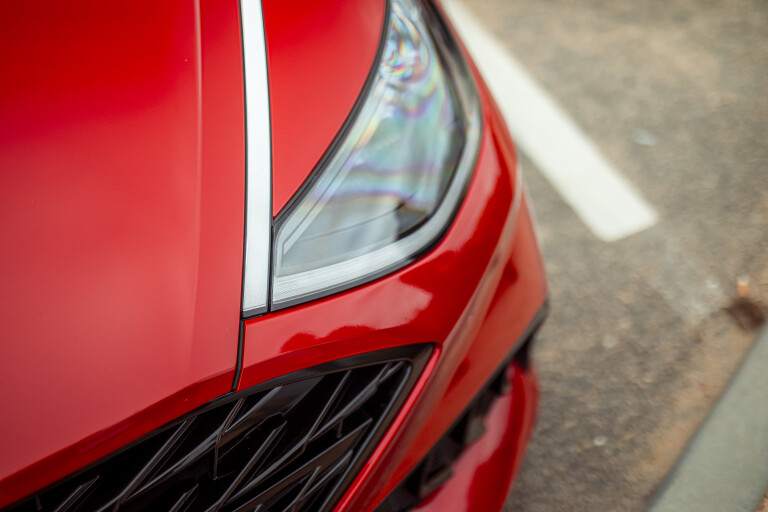
That aside, the Hyundai has great road presence. The corner-to-corner tail lamp graphic looks particularly handsome at night, and even the ‘Sonata’ script on the bootlid isn’t unwelcome. This badge has come a long way from its humble origins as Korea’s Camry.
On the inside, it’s less convincing. Besides committing the same crimes as the Audi with scratchy lower-dash plastics and piano black around key switch blocks, the steering wheel leather feels distinctly faux and the padded door armrests have an unappealing squish to them. As feature-rich as it is, the execution of the Sonata’s cabin does show room for improvement.
And that brings us to the Civic. The Civic is an exercise in quiet achievement, and that’s not exactly the best thing for a car that needs to pull in buyers who may already be put off from stepping into a showroom.
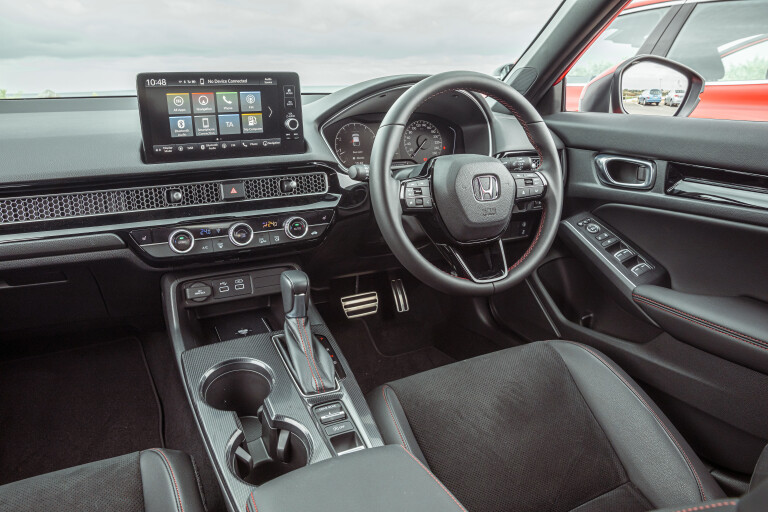
Once inside, however, you can appreciate the latent quality of its furnishings, its fine-grained leather wheel, the tasteful hexagonal mesh that stretches across the dash and the fine joysticks that control each air vent. The chrome dials suck heat from your fingertips like metal does, each button, lever and stalk operate with satisfying haptics, and the driver’s seating position is low-slung, sporty and comfortable.
There are some mis-steps though, with the Civic’s part-analogue, part-digital instrument panel lacking the wow-factor and reconfigurability of the all-digital A3 and Sonata, while its infotainment system is also not quite as intuitive and easy to use as those of the other two – though it’s admittedly a massive step forward from Honda infotainment software of the recent past.
Body quality is also a lowlight, with noticeable orange peel on virtually every panel and panel gaps on all shutlines that seem just a smidge too wide for a vehicle built in 2022.

Also, we miss the rear-facing camera view that the previous generation offered, which made merging left a whole lot safer. The Sonata, meanwhile, has that same feature not just on the left side, but on the right as well.
As far as static showroom assessment goes, the outcome is inconclusive – none are clear winners, though the Honda does at least get fundamentals like packaging and cabin quality right and the Hyundai is positively weighed down with technology and features. The A3 is a backmarker here.
So, to the on-road evaluation. For this, each car was subjected to two road loops: the dynamic country road ‘fun loop’ that journos love but is of dubious value to most buyers, and a 100km urban/highway fuel economy loop that’s a potent sedative for any car journalist, but arguably generates more useful data for the typical punter.

Let’s get the boring one out of the way. Steering the A3 around Melbourne’s urban streets, there’s an effortlessness to the way it gets the task done. It feels light, easy to steer and quite zippy thanks to its generous spread of low-rpm torque, which works nicely with the programming of its seven-speed dual-clutch.
The suspension has a generally taut nature but easily shrugs off big-amplitude obstacles like soft-edged speedbumps without jostling occupants, and while the 18-inchers look a tad undersized, their sidewalls are the right dimensions to filter out the smaller stuff.
Outward visibility is good too. The A3’s glasshouse is big, there’s no privacy tint getting in the way and the rear quarter windows also help shrink the blind spot – not that the door-mounted mirrors really have much of one.

The A3 also has an adaptive engine braking feature, which either uses the engine’s compression or dials up the resistance of the smart alternator (or a combination of the two) to gently hold you back from traffic in front and reduce fuel burn by a fraction. It actually works quite seamlessly, especially on highways, though its impact on fuel economy is hard to measure, and it’s only available with the Comfort pack option.
Also seamless is the 1.4-litre’s cylinder deactivation feature, which shuts down two pots during very light-throttle cruising to save juice. Result: 5.4L/100km over a 70:30 urban/highway cycle in real-world conditions. That’s a pretty great number for a non-hybrid.
The Sonata exists at the opposite end of the spectrum. Perhaps in an effort to justify the N-Line badge in its grille, the suspension has been tuned with body control in mind, however the net result is a suspension that feels unnecessarily firm and has plenty of jiggle on seemingly smooth roads. It’s a lot more cosseting on a highway, however.
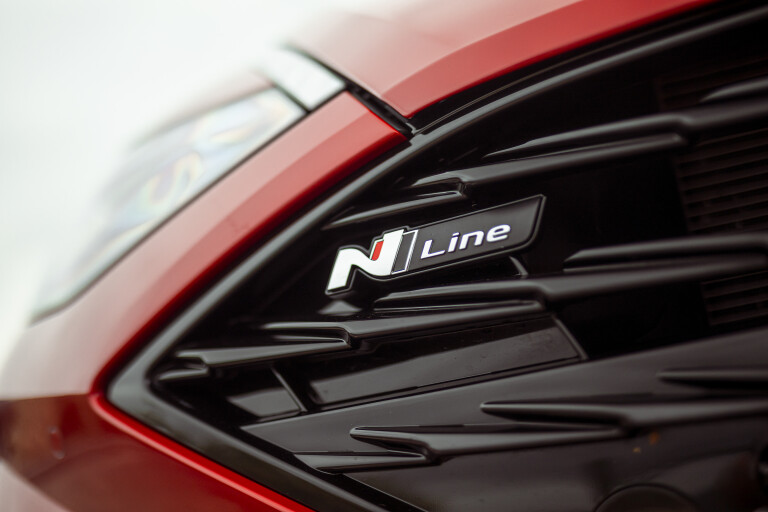
But a bigger issue around town is just how eager it is to pile on speed. It’s not the easiest car to drive smoothly unless you really baby the accelerator, and that’s largely down to the way the Sonata’s 2.5-litre turbo piles on boost from the midrange.
It feels old-school turbo, with miles of upper-revs thrust offset by a fairly benign low-end. If you mush the throttle a little too much to overtake another car or pull out of a side street, tyre chirping and torque steer is often the result.
It’s a big and powerful machine, but is otherwise easy to drive besides its turbo lag. The power steering is light and friendly (though very much lacking in feel), and the aforementioned side-looking indicator cameras help keep tabs on what’s around the Sonata’s sizable hindquarters.

This might make a great limo – it’s big on the inside, effortless on a highway and not too unwieldy for city driving – if it weren’t for one thing: its prodigious thirst. The Sonata averaged 8.0L/100km by the end of that loop, but were it not for the highway component it would have easily recorded an urban average north of 10L/100km.
A heavy car plus a big-boost engine equals pain at the bowser. Another problem that might cost you some money: the speed sign recognition would routinely display the wrong speed, with 100 often showing in areas that were signposted for 80 and vice-versa. Erm, might want to fix that up, Hyundai.
The Civic occupies the safe middle ground. Its economy result was a respectable 6.7L/100km (close to the factory claim of 6.4L/100km), it’s the right size for both city and suburban roads, and its CVT pairs well with the outputs of its 1.5-litre turbo and works fine in a town environment.

However it rode more firmly than anticipated, with a tauter feel than the A3 but less sensitivity than the Sonata. Rearward vision isn’t as good as the A3 either, and we genuinely miss those side cameras. Honda, bring them back ASAP, and while you’re at it maybe take a look at the lane-keep assist calibration – it prevents you from drifting across solid white lines, but is perfectly fine with letting the car stray over dotted lines without so much as a warning.
Transitioning to a twisty road sees the Civic shine. It has a wonderfully balanced chassis, and the firmness that’s noticeable around town turns into an advantage when the road ahead weaves left and right. Roadholding from its Goodyear Eagle F1s is good, the CVT begins working through stepped ratios when you mat the throttle, and the steering is nicely weighted and has a rack ratio that’s not too fast, but not too dozy either.
There’s a bit of throttle hang as the CVT adjusts to throttle lifts and some mild torque steer too, but nothing that gets in the way of enjoying a country drive. Rock-solid and stable, it’s a fine partner for a fun road.
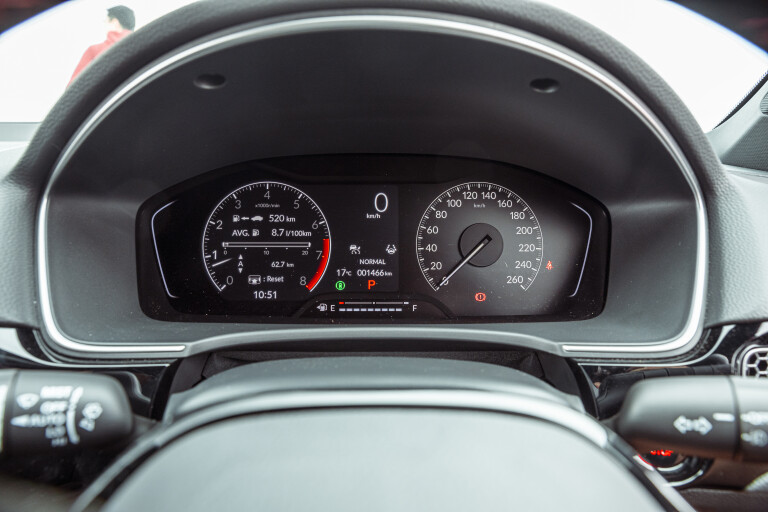
Actually, so is the A3. It generally performed well as a city car but my prediction was it would run out of steam on the winding stuff. Yet while the 110kW 1.4 does indeed get puffed when asked to perform above 80km/h, the chassis is certainly willing to engage with a keen driver. The biggest impediment it has in this environment is the minimal lateral support in its flat-cushioned driver’s seat.
Yet while the other two are adept, if underpowered, the Sonata is the total opposite. Its front Continentals are easily overwhelmed by the massive 422Nm torque output of its 2.5 turbo, and the torque steer can be colossal if you aren’t ready for it. The stiff-legged suspension does actually hang onto corners pretty well considering the car’s weight, but attempting to smoothly get on the power as you pass the apex often sees the balance upset by the sudden onset of boost.
There are many ways of spending fifty grand, but if you were wondering if a near-$50k pricetag for a non-Type R Civic was cheeky, well, it isn’t when judged in the context of what else is available.
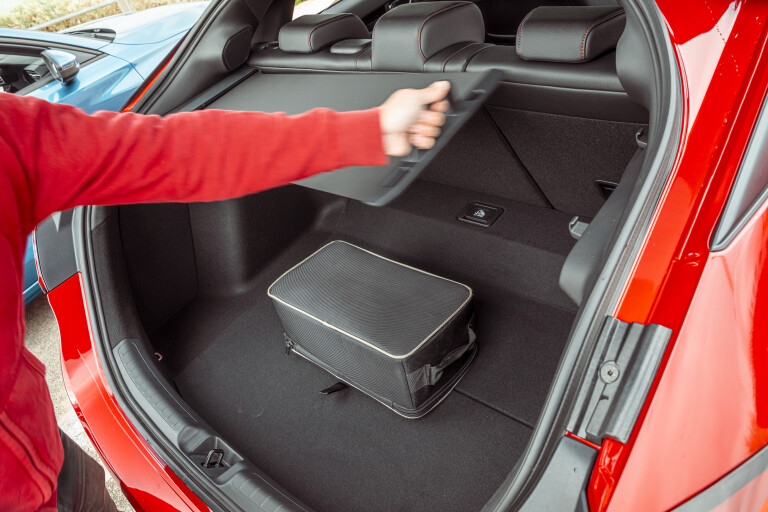
The Sonata, though it gives you plenty of metal for your money, feels rough around the edges in more than one way. The A3, on the other hand, leaves you feeling short-changed – the core of it is undoubtedly good, but the base 35 TFSI gives you the overwhelming feeling that the best examples of the A3 are the ones further up the spec ladder.
But the real threats to the Honda are within the small-car category. We’ve already judged the Mark 8 Golf 110TSI Life to be the category benchmark, and that car starts well below $40K. Another Euro rival is Peugeot’s new-gen 308, arriving soon with the choice of hatch, wagon, hybrid and (eventually) an EV.
If Peugeot can make a diverse small-car lineup work, why can’t Honda? However, judged within the context of its price point, the Civic does present plenty of virtues. Don’t write it off just yet.
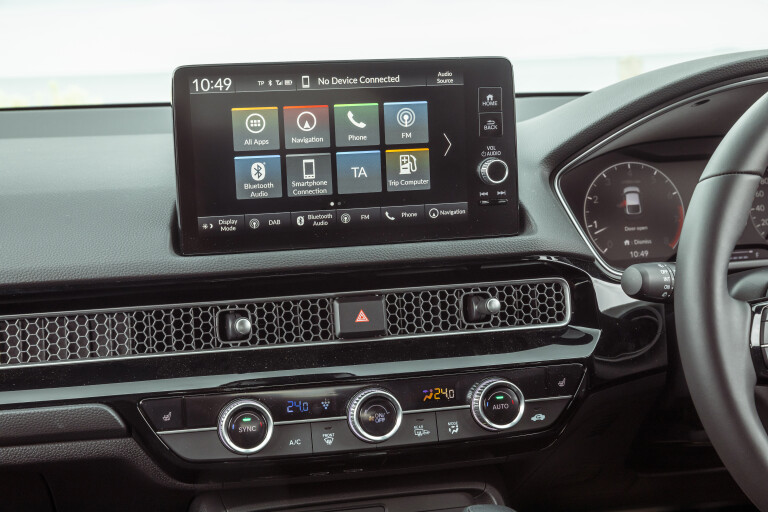
1. Audi A3
The A3 is a small car with a lowercase ‘s’. Back seat accommodation isn’t its strong suit, with cramped footwells, limited knee room and a rear bench that’s both flat and not really wide enough to carry three adults in comfort. It does at least have a light and airy feel though, thanks to a beige headliner and generously-sized glass, while boot capacity is plentiful for a few large suitcases.
With the Comfort Package ($2600) adding powered and heated front seats, adaptive cruise, electric lumbar adjustment and heated/power folding wing mirrors, our A3 looked and felt less plain than it otherwise would in unoptioned trim, though thankfully that crisp and intuitive 10.1-inch infotainment screen and electronic instrument panel are standard-issue.
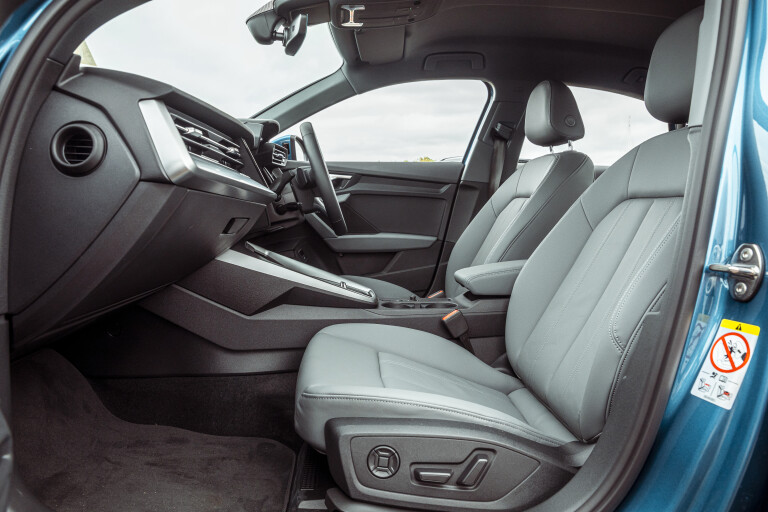
2. Honda Civic
Perhaps one of the biggest things that sets the Civic apart from other small cars is its rear-seat space, which flaunts generous legroom and a comfortable bench and backrest. Three adults would be squeezy though, and headroom is constrained by the diving roofline and there’s a generally cave-like ambience from the black headliner and dark-tinted privacy glass.
Nice-feeling leather upholstery, Bose premium audio, a nine-inch touchscreen, wireless phone charger, dual-zone climate control, heated and powered front seats, active cruise – the Civic has all the basics covered and more, though simply cannot equal the Hyundai’s tech suite.

3. Hyundai Sonata
No surprises that the midsizer has a back-seat advantage, though to be honest it only edges ahead of the spacious Civic due to its provision of more airspace around the noggin. The standard pano sunroof also extends over the rear seats too, which is a nice touch, and the boot is definitely well suited to hotel transfer duty.
The Sonata N-Line is the most expensive in the gang, but besides its larger form factor the Sonata justifies its additional cost by packing in a feature set that encompasses luxuries like a panoramic glass sunroof, a head-up display, heated and cooled front seats, heated rear seats, leather, active cruise, retractable rear sunblinds and more.
SCORING
Honda Civic VTi-LX: 7.5/10
Audi A3 35 TFSI: 6.5/10
Hyundai Sonata N-Line: 7.0/10
| Honda Civic | Audi A3 35 TFSI sedan | Hyundai Sonata N-Line | |
|---|---|---|---|
| $47,200/as tested $47,200 da | $49,400/as tested $53,360 | $51,565/as tested $51,565 | |
| DRIVETRAIN | |||
| Engine | 4cyl, dohc, 16v, turbo | 4cyl, dohc, 16v, turbo | 4cyl, dohc, 16v, turbo |
| Layout | front engine (east-west), FWD | front engine (east-west), FWD | front engine (east-west), FWD |
| Capacity | 131kW @ 6000rpm | 1498cc | 2497cc |
| Power | 239kW | 110kW @ 6000rpm | 213kW @ 5800rpm |
| Torque | 240Nm @ 1700-4500rpm | 250Nm @ 1500-3500rpm | 422Nm @ 1650-4000rpm |
| Gearbox | CVT | 7-speed dual-clutch | 8-speed dual-clutch |
| CHASSIS | |||
| Body | steel, 5 doors, 5 seats | steel, 4 doors, 5 seats | steel, 4 doors, 5 seats |
| L/W/H/W–B | 4560/1802/1415mm/2735mm | 4495/1816/1425/2636mm | 4900/1860/1445/2840mm |
| Track (F/R) | 1537/1577mm | 15445/1532mm | 1610/1617mm |
| Weight | 1369kg | 1285kg | 1636kg |
| Boot | 404 litres | 425 litres | 510 litres |
| Fuel | 95RON/50 litres | 95RON/50 litres | 91RON/60 litres |
| Economy | 6.1L/100km (ADR combined) | 4.9L/100km (ADR combined) | 8.1L/100km (ADR combined) |
| Suspension | Front: struts, A-arms, anti-roll bar Rear: multi-links, coil springs, anti-roll bar | Front: struts, A-arms, anti-roll bar Rear: multi-links, coil springs, anti-roll bar | Front: struts, A-arms, anti-roll bar Rear: multi-links, coil springs, anti-roll bar |
| Steering | electric rack-and-pinion | electric rack-and-pinion | electric rack-and-pinion |
| Brakes | ventilated discs (282mm) | ventilated discs (312mm) | ventilated discs (320mm) |
| Rear brakes | ventilated discs (260mm) | solid discs (272mm) | solid discs (284mm) |
| Tyres | Goodyear Eagle F1 | Bridgestone Turanza T005 | Continental ContisportContact6 |
| Tyre size | 235/40R18 | 225/40R18 | 245/40R19 |
| SAFETY | |||
| ANCAP rating | TBC (not yet tested) | 5 stars (tested 2020) | TBC (not yet tested) |
| PERFORMANCE | |||
| 0-100km/h | 8.2sec (tested) | 8.4sec (claimed) | 6.2sec (claimed) |
| Warranty | 5 years/unlimited km | 5 years/unlimited km | 5 years/unlimited km |
| Service interval | 12 months/10,000km | 12 months/15,000km | 12 months/10,000km |

COMMENTS